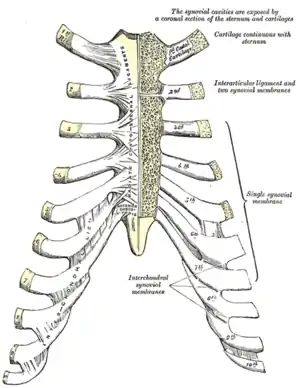Tietze syndrome
Tietze syndrome (also called costochondral junction syndrome) is a benign inflammation of one or more of the costal cartilages.[1] It was first described in 1921 by the German surgeon Alexander Tietze (1864–1927).[2][3]
| Tietze syndrome | |
|---|---|
| Other names | Chondropathia tuberosa, costochondral junction syndrome |
 | |
| Sternocostals and interchondral articulations. Anterior view. (Costal cartilages visible on diagram.) | |
| Specialty | Rheumatology |
Tietze syndrome is not the same as costochondritis.[4] Tietze syndrome is differentiated from costochondritis by swelling of the costal cartilages, which does not appear in costochondritis. Like costochondritis, it was at one time thought to be associated with, or caused by, a viral infection acquired during surgery. This is now known not to be the case, as most sufferers have not had recent surgery.
Signs and symptoms
The main presentation of the syndrome is significant, acute pain in the chest, along with tenderness and some swelling of the cartilages affected, which is commonly palpable on examination. Perceived pain is often exacerbated with respiration.[5] Although many times it can be extremely painful, to the point of being debilitating, Tietze's syndrome is considered to be a benign condition that generally resolves in 12 weeks. However, it can often be a chronic condition. The associated chest pain may present similarly to angina pectoris, normally associated with heart disease, and can cause hyperventilation, anxiety or panic attacks, syncope (passing out), and temporary hypoesthesia (numbness) paralysis, and due to pain high blood pressure or hypertension. In some cases, the pain may be perceived as 10 to 20 times more painful than normalized costochondritis.
Many cases of myocardial infarction (heart attack) patients have been re-considered and improperly diagnosed, due to the identical nature of the symptoms. In females, it is often misdiagnosed as mastalgia. Costochondritis symptoms are similar to Tietze's, the prime difference being that the pain radiates to the arms and shoulders in the latter.
Cause
While the true causes of Tietze's syndrome are not well understood, it often results from a physical strain or injury, such as repeated coughing, sneezing, vomiting, or impacts to the chest. It has even been known to occur after hearty bouts of laughter. It can occur by overexertion or by an injury or trauma to the thorax.
Tietze's syndrome is not thought to be an inherited condition[6] and it affects males and females equally.[1]
Psychological stress can exacerbate Tietze's syndrome through chest muscle contraction, but there is no evidence to suggest that it is a direct cause.
Patients who have had radiation therapy to the chest/breast will often experience this syndrome which can occur shortly after therapy or years later. It is found more often in teens than adults.
Diagnosis
Differential diagnosis
Although patients will often mistake the pain of Tietze's syndrome for a myocardial infarction (heart attack), the syndrome does not progress to cause harm to any organs. Other potential causes for chest pain include cardiac, gastrointestinal, or traumatic injury.
It is important to rule out a heart attack, as the symptoms may be similar or severe. After assessment, providers often reassure patients that their symptoms are not associated with a heart attack, although they may need to treat the pain, which in some cases can be severe enough to cause significant, though temporary, disability to the patient. Pain relief is achieved with the use of analgesics.
Treatment
After medical assessment and confirmation of no immediate cardiology events, especially heart attack, normal treatment includes rest by reducing activities affecting the chest. Administering anti-inflammatory drugs including naproxen, ibuprofen, aspirin, and acetaminophen[7] is recommended. For very painful and debilitating events, where the pain is unbearable or requires emergency care, Toradol is generally prescribed and administered by direct injection.[8] This can relieve most of the pain in 5 to 10 minutes. Other treatment steps include physical therapy, applying ice packs on the chest area to reduce the swelling, and applying an analgesic patch that may also contain lidocaine. Glucocorticoid steroids may be prescribed in order to reduce the inflammation.[7] If the pain is reoccurring, doctors may also recommend tricyclic antidepressants such as amitriptyline, which is often used to control pain when patients find it difficult to sleep at night. The anti-seizure medication gabapentin (Neurontin) has also proven successful in controlling chronic pain.[9] If the pain is severe enough and reoccurring, a doctor may prescribe a medication containing codeine, such as Codeine/Acetaminophen (Tylenol No.1, No.2, No.3 or No.4). However, because codeine can be habit forming, it is generally only prescribed when Toradol or other analgesics have failed to provide sufficient relief.[10][11]
References
- "Tietze Syndrome". NORD (National Organization for Rare Disorders). Retrieved 2016-03-01.
- synd/2640 at Who Named It?
- Tietze A (1921). "Über eine eigenartige Häufung von Fällen mit Dystrophie der Rippenknorpel". Berliner klinische Wochenschrift. 58: 829–831.
- "Tietze's Syndrome".
- Bhat, Sriram (2010). Tietze's disease. New Delhi, India: SRB's Manual of Surgery. p. 554.
- "Tietze syndrome | Genetic and Rare Diseases Information Center (GARD) – an NCATS Program". rarediseases.info.nih.gov. Retrieved 2018-04-25.
- "Tietze Syndrome - Symptoms, Causes, Treatment, Pictures". syndrome.org. Retrieved 2018-01-29.
- "Costochondritis Treatment". Anxiety Keep. Retrieved 2018-01-29.
- "Costochrondritis: Diagonosis and Treatment". Mayo Clinic. Retrieved 2018-08-05.
- Phillips K, et al. Treatment of musculoskeletal chest pain. http://www.uptodate.com/home. Retrieved 2018-08-05
- McMahon SB, et al. "Thoracic pain" in Wall & Melzack's Textbook of Pain. 6th ed. Philadelphia, Pa.: Saunders Elsevier; 20015.Retrieved 2018-08-05.
External links
- Overview at Mayo Clinic
- Costochondritis and Tietze Syndrome
- Costochondritis at WebMD
- Clinical presentation and chiropractic treatment of Tietze syndrome at National University of Health Sciences
| Classification | |
|---|---|
| External resources |